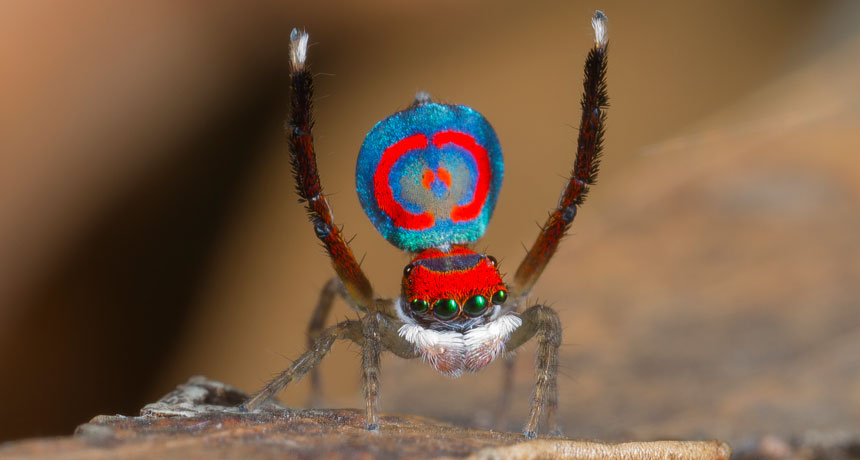Peacock spider’s radiant rump comes from teeny tiny structures
Pigments produce reds and creamy yellows, while nanostructures turns other parts blue

The peacock spider gets its blue bling from small reflective structures.
Share this:
- Share via email (Opens in new window) Email
- Click to share on Facebook (Opens in new window) Facebook
- Click to share on X (Opens in new window) X
- Click to share on Pinterest (Opens in new window) Pinterest
- Click to share on Reddit (Opens in new window) Reddit
- Share to Google Classroom (Opens in new window) Google Classroom
- Click to print (Opens in new window) Print
Male peacock spiders know how to work their angles and find their light. These arachnids are native to Australia. And males are quite a sight to see. They rely on the vibrant hues coloring their hind ends to attract females. A guy will raise skyward his derriere — or, more accurately, a flap on his hind end — and shake it catch the gals’ attention. Now scientists have figured out where his fancy colors come from.
Doekele Stavenga is an expert in optics at the University of Groningen in the Netherlands. He and his colleagues started by collecting peacock spiders. They found these specimens of Maratus splendens in a park outside Sydney, Australia. Then they zoomed in on the scales that cover the spiders’ rears.
The team used microscopy, spectrometry and other techniques to image the scales. The red, yellow and cream scales rely on two pigments to reflect their colors. (Pigments are chemicals that reflect light to produce colors.) Even the white scales contained low levels of pigment. Spines lining these scales scatter light randomly. That gives them slightly different hues when viewed from different angles.

Blue scales worked differently. They’re transparent and lack pigment. Instead, the shape of the scales cause them to reflect iridescent blue and purple hues. Each scale resembles a sac or a peapod. It is lined with tiny ridges on the outside. Inside there’s a layer of threadlike fibers. The spacing of those fibers may determine whether scales appear more blue or more purple.
Whether peacock spiders’ eyes can actually see these posterior patterns is not certain, the researchers say. Species of jumping spiders can see at least three color ranges, just as humans do. So it seems unlikely that such vivid, come-hither dance moves play out in only black and white.
The findings appear in the August Journal of the Royal Society Interface.







